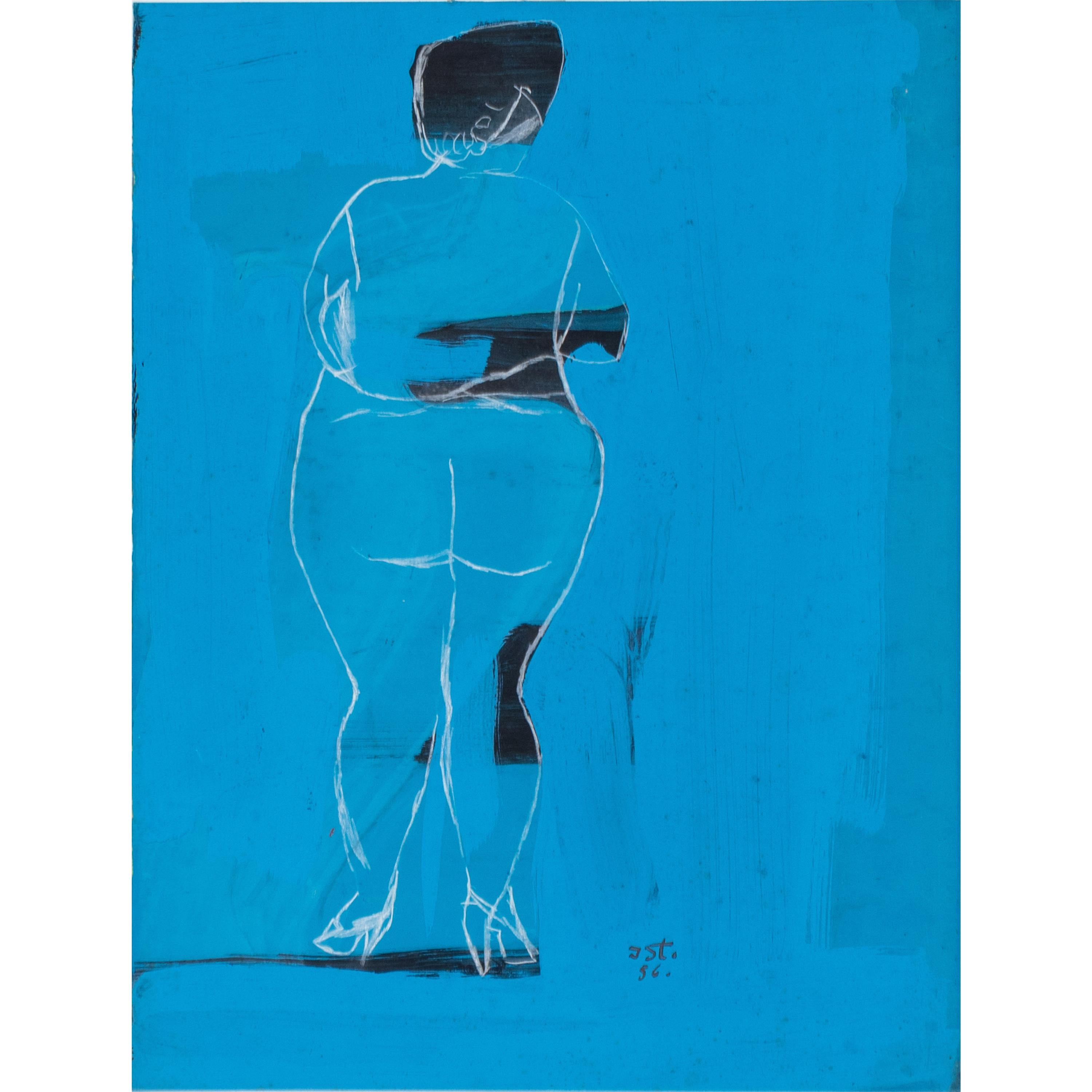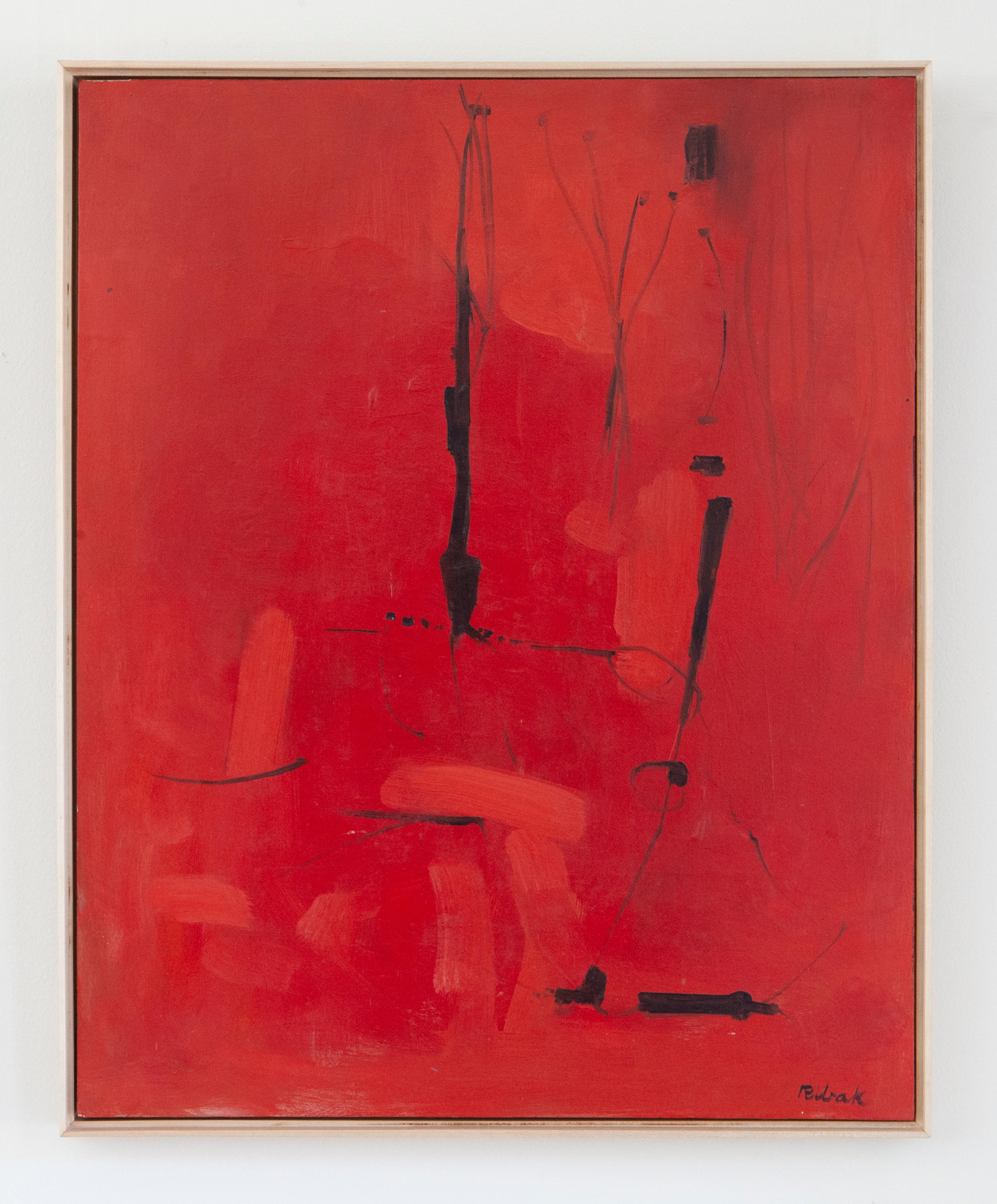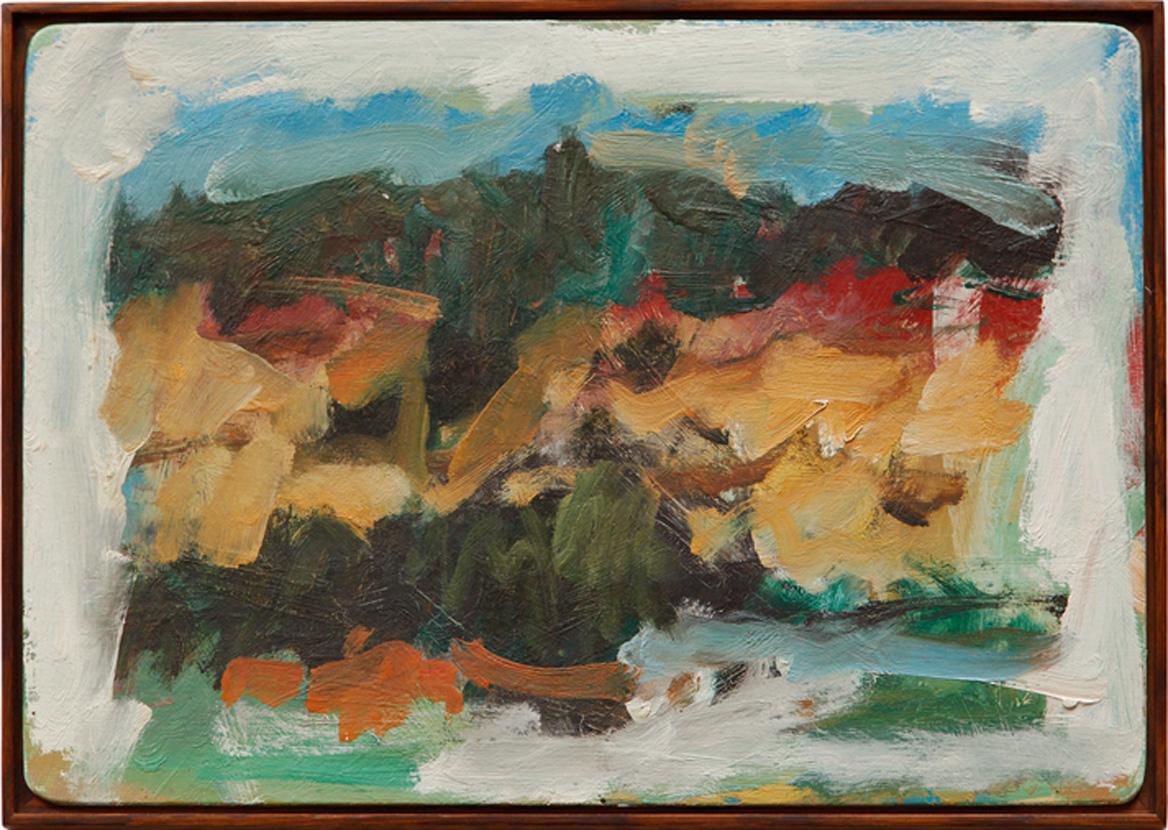Tobias Musicant"House in Fragments"
About the Item
- Creator:
- Dimensions:Height: 33 in (83.82 cm)Width: 29 in (73.66 cm)Depth: 3 in (7.62 cm)
- More Editions & Sizes:Framed Size 32" x 28"Price: $23,125
- Medium:
- Movement & Style:
- Period:
- Condition:
- Gallery Location:Lambertville, NJ
- Reference Number:
Tobias Musicant
A new discovery in the art world is something always searched for and rarely found. Surely there was no shortage of artists during the 20th century, but to find someone of immense talent and individuality that has seemingly slipped under the radar of galleries, critics and collectors is rare. An instance where this might occur is when an artist may have been his or her own harshest critic and, for fear of rejection or criticism, such an artist might choose to never show their work in major venues. Somewhere along the way in the promising career of Tobias “Ted” Musicant, his personal insecurity kept his artistic genius from the field of his peers. After participating in numerous prestigious exhibitions early in his career, Musicant became reclusive and kept his art from the public eye. Since the relatively recent death of this artist, a small but powerful body of Modernist paintings has been discovered. These works range in date from 1940 to 1965 and begin in a representational modernist style, evolving into a very interesting and appealing semi-representational hard-edged geometric series that incorporate a flavor of Native American influence. The latest of his paintings are of a surrealist style where the artist includes elements such as birds, fruit, a myriad of unusual objects and architecture into his compositions. His work bears similarities to that of Marsden Hartley, Stuart Davis, Louis Stone and Salvador Dali.
Tobias Musicant was the son of a carpenter and born in Philadelphia in 1921. An artist since childhood, after high school, Musicant attended the Pratt Institute in New York from 1939–41. However, his art studies would be interrupted by World War II as he served his country in the United States Army Air Force, seeing action in England. After the war, Musicant continued his studies at the Art Students League from 1945–48. He lived in Brooklyn in the 1940s and 1950s, eventually moving to Plainsboro, New Jersey, with his sister Alice Musicant, also an artist, where they would both remain throughout their lives. His paintings were exhibited in the Metropolitan Museum of Art in New York, the Pennsylvania Academy of the Fine Arts, the Philadelphia Print Club, the Newark Museum, the Brooklyn Museum, the Butler Institute, and the Princeton Art Council, among other venues. He also had one-man shows at Heffers Gallery in Cambridge, England and the Contemporary Arts Gallery in New York City. In addition to his paintings, Musicant worked in enamels and made silver jewelry.
- ShippingRetrieving quote...Ships From: Lambertville, NJ
- Return PolicyThis item cannot be returned.
- “Woman in Black”By Vaclav VytlacilLocated in Lambertville, NJJim’s of Lambertville is proud to offer this artwork by: Vaclav Vytlacil (1892-1984) He was born to Czechoslovakian parents in 1892 in New York City. Living in Chicago as a youth, he took classes at the School of the Art Institute of Chicago, returning to New York when he was 20. From 1913 to 1916, he enjoyed a scholarship from the Art Students League, and worked with John C. Johansen (a portraitist whose expressive style resembled that of John Singer Sargent), and Anders Zorn. He accepted a teaching position at the Minneapolis School of Art in 1916, remaining there until 1921. This enabled him to travel to Europe to study Cézanne’s paintings and works of the Old Masters. He traveled to Paris, Prague, Dresden, Berlin, and Munich seeking the works of Titian, Cranach, Rembrandt, Veronese, and Holbein, which gave him new perspective. Vytlacil studied at the Royal Academy of Art in Munich, settling there in 1921. Fellow students were Ernest Thurn and Worth Ryder, who introduced him to famous abstractionist Hans Hofmann. He worked with Hofmann from about 1922 to 1926, as a student and teaching assistant. During the summer of 1928, after returning to the United States, Vytlacil gave lectures at the University of California, Berkeley, on modern European art. Soon thereafter, he became a member of the Art Students League faculty. After one year, he returned to Europe and successfully persuaded Hofmann to teach at the League as well. He spent about six years in Europe, studying the works of Matisse, Picasso, and Dufy. In 1935, he returned to New York and became a co-founder of the American Abstract Artists group in 1936. He later had teaching posts at Queens College in New York; the College of Arts and Crafts in Oakland, California; Black Mountain College in North Carolina; and the Art Students League. His paintings exhibit a clear inclination toward modernism. His still lives and interiors from the 1920s indicate an understanding of the art of Cézanne. In the 1930s, his works displayed two very different kinds of art at the same time. His cityscapes and landscapes combine Cubist-inspired spatial concerns with an expressionistic approach to line and color. Vytlacil also used old wood, metal, cork, and string in constructions, influenced by his friend and former student, Rupert Turnbull. He eventually ceased creating constructions as he considered them too limiting. The spatial challenges of painting were still his preference. During the 1940s and 1950s, his works indicated a sense of spontaneity not felt in his earlier work. He married Elizabeth Foster in Florence, Italy, in 1927 and they lived and worked in Positano, Italy for extended periods of time. Later on, they divided their time between homes in Sparkill, New York and Chilmark, Massachusetts, where Vyt, as he was affectionately called, taught at the Martha's Vineyard Art...Category
1960s Abstract Expressionist Figurative Paintings
MaterialsOil, Board
- “Woman on the Rocks”By Josef ZenkLocated in Lambertville, NJJim’s of Lambertville is proud to offer this artwork by: Josef Zenk (1904-2000) Josef Zenk was born in New York City in 1904. After graduating from high school, he studied for thre...Category
20th Century Abstract Figurative Paintings
MaterialsOil, Board
- "Lower Manhattan"By Vaclav VytlacilLocated in Lambertville, NJSigned & dated 1940 lower left. Vaclav Vytlacil (1892-1984) He was born to Czechoslovakian parents in 1892 in New York City. Living in Chicago as a youth, he took classes at the S...Category
1940s Abstract Abstract Paintings
MaterialsOil, Board
- "Roman Bath" Series (2/3)By Vaclav VytlacilLocated in Lambertville, NJJim’s of Lambertville is proud to offer this artwork by: Vaclav Vytlacil (1892-1984) He was born to Czechoslovakian parents in 1892 in New York City. Living in Chicago as a youth, he took classes at the School of the Art Institute of Chicago, returning to New York when he was 20. From 1913 to 1916, he enjoyed a scholarship from the Art Students League, and worked with John C. Johansen (a portraitist whose expressive style resembled that of John Singer Sargent), and Anders Zorn. He accepted a teaching position at the Minneapolis School of Art in 1916, remaining there until 1921. This enabled him to travel to Europe to study Cézanne’s paintings and works of the Old Masters. He traveled to Paris, Prague, Dresden, Berlin, and Munich seeking the works of Titian, Cranach, Rembrandt, Veronese, and Holbein, which gave him new perspective. Vytlacil studied at the Royal Academy of Art in Munich, settling there in 1921. Fellow students were Ernest Thurn and Worth Ryder, who introduced him to famous abstractionist Hans Hofmann. He worked with Hofmann from about 1922 to 1926, as a student and teaching assistant. During the summer of 1928, after returning to the United States, Vytlacil gave lectures at the University of California, Berkeley, on modern European art. Soon thereafter, he became a member of the Art Students League faculty. After one year, he returned to Europe and successfully persuaded Hofmann to teach at the League as well. He spent about six years in Europe, studying the works of Matisse, Picasso, and Dufy. In 1935, he returned to New York and became a co-founder of the American Abstract Artists group in 1936. He later had teaching posts at Queens College in New York; the College of Arts and Crafts in Oakland, California; Black Mountain College in North Carolina; and the Art Students League. His paintings exhibit a clear inclination toward modernism. His still lives and interiors from the 1920s indicate an understanding of the art of Cézanne. In the 1930s, his works displayed two very different kinds of art at the same time. His cityscapes and landscapes combine Cubist-inspired spatial concerns with an expressionistic approach to line and color. Vytlacil also used old wood, metal, cork, and string in constructions, influenced by his friend and former student, Rupert Turnbull. He eventually ceased creating constructions as he considered them too limiting. The spatial challenges of painting were still his preference. During the 1940s and 1950s, his works indicated a sense of spontaneity not felt in his earlier work. He married Elizabeth Foster in Florence, Italy, in 1927 and they lived and worked in Positano, Italy for extended periods of time. Later on, they divided their time between homes in Sparkill, New York and Chilmark, Massachusetts, where Vyt, as he was affectionately called, taught at the Martha's Vineyard Art...Category
20th Century Abstract Impressionist Abstract Paintings
MaterialsOil, Board
- "Agitation in the Agora"By Tobias MusicantLocated in Lambertville, NJJim’s of Lambertville is proud to offer this artwork by: Tobias Musicant (1921 – 2004) A new discovery in the art world is something always searched for and rarely found. Surely th...Category
20th Century Abstract Abstract Paintings
MaterialsOil, Board
- "Sea and Sky, Deer Isle"By Mercedes MatterLocated in Lambertville, NJJim’s of Lambertville is proud to offer this artwork by: Best known as a painter of abstract still life and founder of the New York Studio School, Mercedes Matter was also a disting...Category
Mid-20th Century Abstract Abstract Paintings
MaterialsCanvas, Oil, Board
- Josef Steiner (1899-1977), Abstract female nude, dated 1956By Josef SteinerLocated in Greding, DEAbstract female figure on a blue ground. Monogrammed and dated in the lower centre. Josef Steiner (1899 Munich - 1977 ibid.) lived through a Germany in all its facets as an artist. A...Category
20th Century Abstract Expressionist Nude Paintings
MaterialsOil, Cardboard
- Committed to the Earth: Black and Pink Minimalist PaintingLocated in Petaluma, CAThis diptych painting of black and pink is slightly recessed within a black frame. The left side depicts simple marks using graphite pencil. The image on the right conveys a circul...Category
21st Century and Contemporary Abstract Abstract Paintings
MaterialsOil, Acrylic, Board
- Burning WoodsBy Louis RibakLocated in Austin, TXOil on masonite. Signed lower right and on verso. 30 x 24 in. 31 x 25 in. (framed) Custom framed in maple. Louis Leon Ribak was born in the Russian empirical governorate of Grodno in 1902. A long-disputed region that is ethnically Lithuanian, at present day, Grodno is located in the western reaches of the Republic of Belarus, near the borders with Poland and Lithuania. At the age of ten, Ribak and his family immigrated to New York City. In 1922, he attended the Pennsylvania Academy of Fine Arts, followed by studies at the Art Students League (1923) and the Educational Alliance (1924). Ribak’s oeuvre can be largely delineated between two stylistic phases: social realism and abstraction, the former taking hold during the 1930s and 40s. During that period, he had several solo exhibitions at the A.C.A. Gallery in New York, while also regularly exhibiting with “An American Group Inc.” - a cohort of socially-conscious painters that included Stuart Davis, Reginald Marsh, Maurice Sterne, and Raphael Soyer. In 1933, Ribak assisted Diego Rivera on the mural for the lobby of Rockefeller Center, while also being employed by the Works Progress Administration (WPA) as a muralist. Louis Ribak met fellow artist Beatrice Mandelman at a dance sponsored by the Artists Union in New York. They were married in 1942, and shortly thereafter, he was drafted for military service in World War II. After his discharge from the service in 1942 due to difficulties with asthma, Mandelman and Ribak traveled west to visit his former mentor John Sloan in Santa Fe, NM. By this time, the couple had become disenchanted with the art scene in New York, and in light of the need to find a healthier climate for Ribak’s asthma - as well as reputed FBI surveillance based on political affiliations with Communist sympathizers - they decided to permanently relocate to the emerging artists’ colony of Taos, NM in 1944. This change of scenery ushered in the second phase of Ribak’s stylistic career, with his work shifting from social realism toward abstraction. He was captivated by the landscape and the diverse cultures of northern New Mexico, the influences of which began to appear in his work. Ribak founded the Taos Valley Art School in 1947, offering no ideology to his students; instead arguing that the adoption of a single approach would lead to academicism. Ribak was an integral force in the development of the Taos Moderns...Category
1960s Abstract Abstract Paintings
MaterialsMasonite, Oil, Board
- UntitledBy Eugene PizzutoLocated in London, GBBeautiful oil painting on board, attributed to Eugene Pizzuto (1925 - 2004). Framed size: 32 x 44 cm Framing: Hand-stained and waxed oak tray frame. Signature: Unsigned. * About t...Category
Mid-20th Century Abstract Expressionist Abstract Paintings
MaterialsOil, Board
- German Contemporary Art by Ursula Krauss - MemmeBy Ursula KraussLocated in Paris, IDFOil on board, frame includedCategory
2010s Abstract Abstract Paintings
MaterialsOil, Board
- German Contemporary Art by Ursula Krauss - Untitled 2By Ursula KraussLocated in Paris, IDFOil on board, frame includedCategory
2010s Abstract Abstract Paintings
MaterialsBoard, Oil





